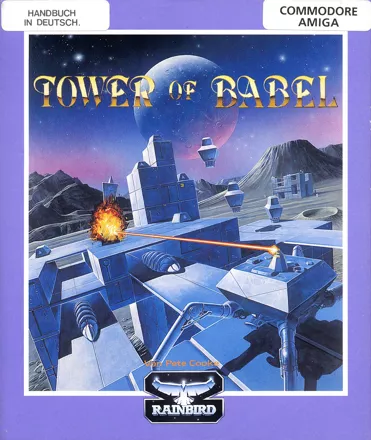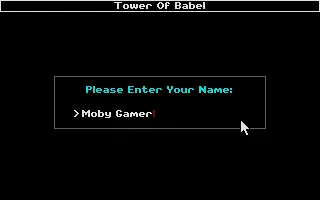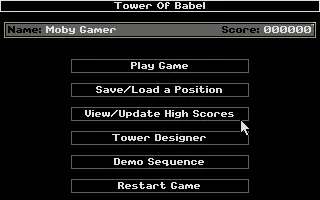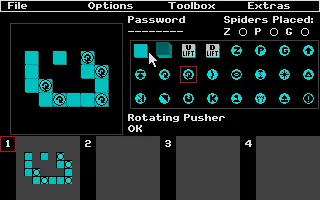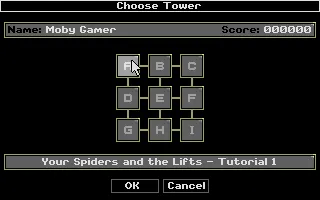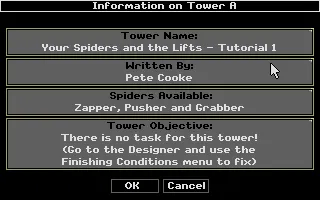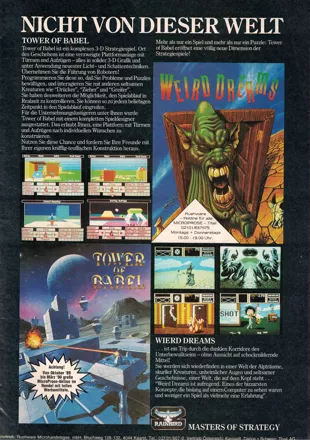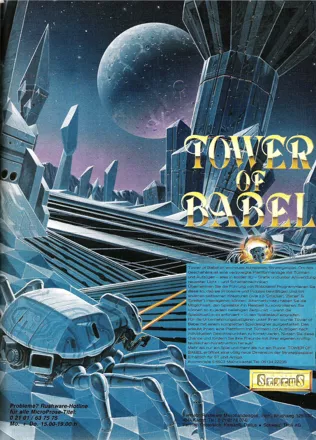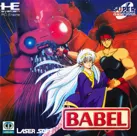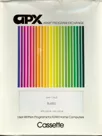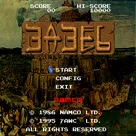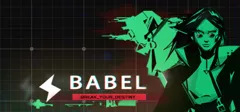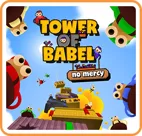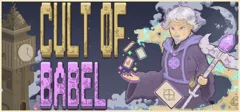Tower of Babel
-
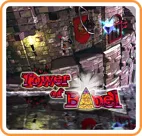 Tower of Babel
(2017 on
Nintendo Switch)
Tower of Babel
(2017 on
Nintendo Switch)
Description official descriptions
The Zapper, Pusher, and Grabber robots were dropped onto the planet of the Shinerians, but are now desperate to return home. They have killed off the Shinerian race but must climb a high tower, negotiating all the traps it holds, before they can contact their masters.
Each robot's name indicates what its main function and purpose are, and these skills must be combined for success. Each section has its own task - collecting energy pods and destroying mines and bombs for example. The creatures which fill the towers must be avoided, or used to your advantage.
The game is viewed through a rotating camera with variable zoom, giving the game an advanced 3D feel for the day. A level designer has also been included.
Groups +
Screenshots
Promos
Credits (Atari ST version)
7 People
| Game by | |
| Sound code by | |
| Disc code by | |
| Tower designs by | |
| Title screen / panel by | |
| Managing the Impossible! |
Reviews
Critics
Average score: 84% (based on 19 ratings)
Players
Average score: 4.4 out of 5 (based on 2 ratings with 1 reviews)
The Good
Tower of Babel is an interesting old puzzle game. It belongs to a venerable genre whereby you have multiple actors who each have a certain skill, and you must these skills in concert to negotiate a challenging environment. In this case you have a robot that can blow things up, a robot with a magical pushing beam, and a third robot that can manipulate objects. You could also push and zap your own robots. Your job was to collect a bunch of crystals called klondikes. I do not know why they were called klondikes.
Most games of this type were simple 2D top-down affairs, but Tower of Babel was in 3D and had simple, attractive filled polygons, with an abstract look. There was no music and the few sound effects were mostly white noise and tinkles, which made the whole thing seem very mysterious and atmospheric. In this respect it was reminiscent of a contemporary 3D game called Archipelagos, although Tower of Babel had multi-storey environments.
Like a lot of people I bought the game because of the polygonal look, and then gave up after a few levels because it was tricky. After a while I picked it up again, and became addicted. It's a fiendishly clever game that rewards logical thinking. You could program your three robots to perform actions in parallel, and in theory you could solve each level by programming everything in advance and just clicking "play". I remember messing things up a lot, and having my robots walk blithely into certain doom. It was a meaty game.
There was a level editor, which was a nice touch, but I never used it. Back when the game came out there was no easy way to distribute levels to the very few people who had bought the game.
The Bad
Taken on its own merits Tower of Babel cannot easily be faulted. But it was a very stark and austere game. It often felt like an exercise in applied logic rather than an entertainment; each level had only one solution and, as I have said, you could theoretically program everything in advance and go off to make tea. There was no replay value. Some of the puzzles were frustratingly tight.
The gameplay reached a plateau of difficulty after a few levels, after which it became slightly easier. The later levels were generally larger and more complex than the earlier levels, but not much harder, because there were only so many permutations of the various game elements. After a while it seemed as if the designer had run out of inspiration.
I did eventually reach the very end, without cheating. I remember being stuck on the final level, and concluding that it was impossible to complete; there were only a finite amount of moves you could make with the given robots, and none of them solved the puzzle. The game did not seem to have an end.
The Bottom Line
Tower of Babel received glowing reviews from the British computing press, although it was clearly a minority-appeal title and it sold in tiny quantities. I believe there is an unofficial remake in the works, although not by Pete Cooke, the original author.
Pete Cooke was a legend of the British 8-bit home computer scene during the 1980s. He wrote a series of classic games that pushed the technical envelope, such as Tau Ceti and Micronaut One, both of which had advanced 3D graphics. He also had a sideline in simple puzzle games, and Tower of Babel was basically a combination of his two obsessions. As far as I know it was his last ever solo games project, although he still works in the industry.
Tower of Babel itself feels alien and a bit old-fashioned nowadays. The game was a co-production between Microprose and Rainbird, neither of which exist today, and I have no idea how you would go about obtaining or playing this game on a modern PC.
Atari ST · by Ashley Pomeroy (225) · 2007
Trivia
Awards
- Amiga Joker
- Issue 01/1991 – #5 Best Strategy Game in 1990
- Amiga Power
- May 1991 (Issue #00) - #50 in the "All Time Top 100 Amiga Games"
- Power Play
- Issue 01/1990 - #3 Best Game Idea in 1989
- Issue 01/1990 - #2 Best Strategy Game in 1989
- ST Format
- January 1990 (Issue #06) - Included in the list 50 Games of the Year
- August 1991 (Issue #8) – #15 Top Atari ST Classic Games (Editorial staff vote)
Analytics
Identifiers +
Contribute
Are you familiar with this game? Help document and preserve this entry in video game history! If your contribution is approved, you will earn points and be credited as a contributor.
Contributors to this Entry
Game added by Martin Smith.
Acorn 32-bit added by Kabushi.
Additional contributors: Patrick Bregger, Jo ST.
Game added April 28th, 2005. Last modified October 9th, 2023.
